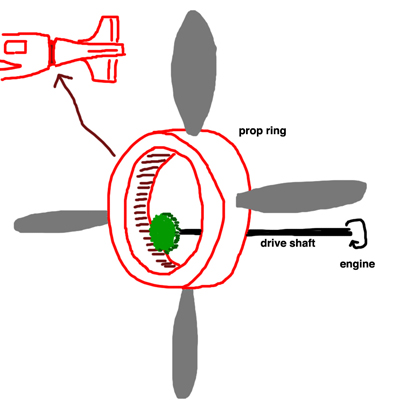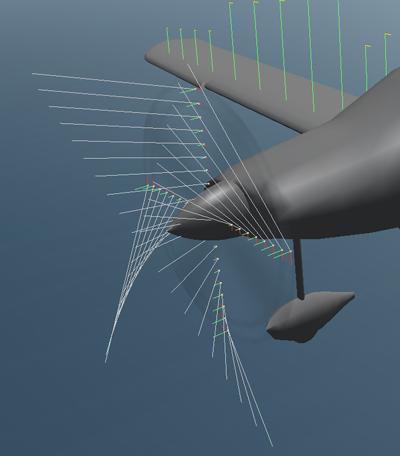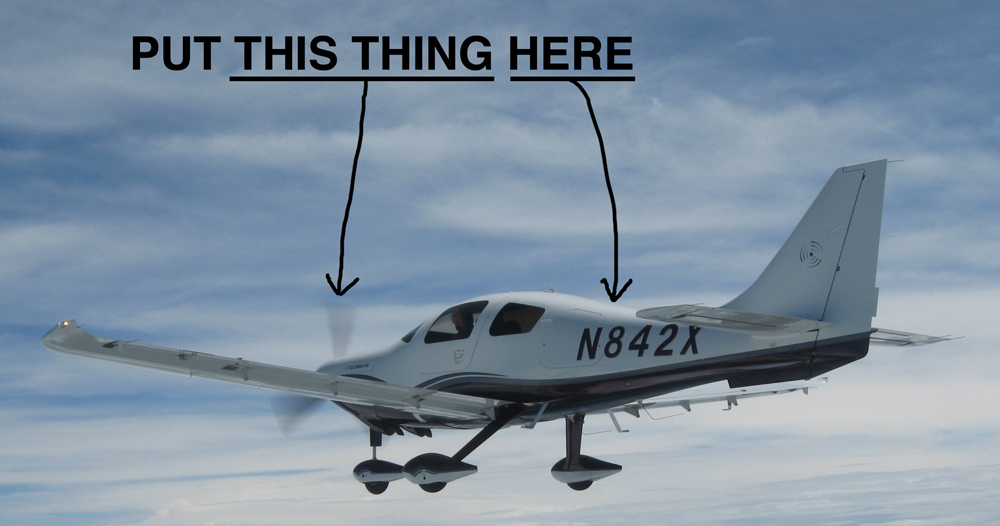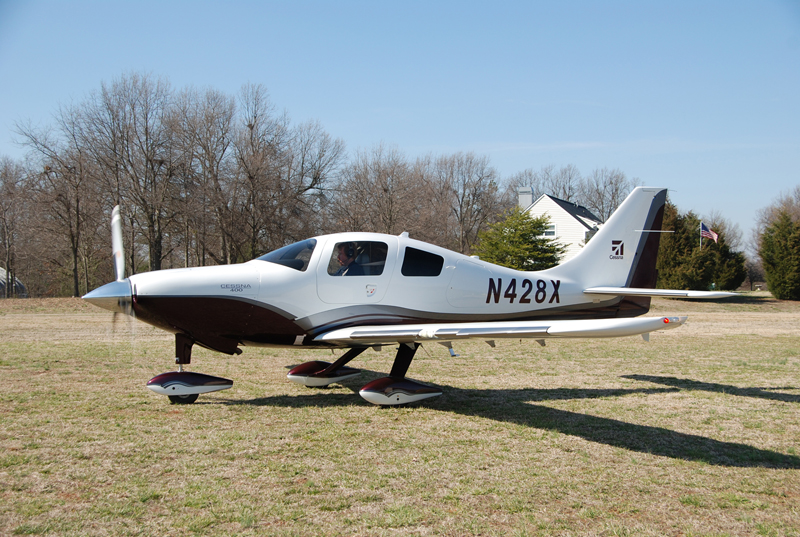
This is the current page for the The X-1-IO-550, a plane designed to demonstrate my 'Ring Prop' idea.
(Heck, someone else has probably already had this idea, but now I am having it and wanna test-fly it... observe the prop in the MIDDLE of this Columbia-400. According to X-Plane, it has a 15-to-30-knot advantage over a stock Columbia-400 at 17,000 ft, 65% power cruise)

Here is the idea behind this plane: I believe that the propulsive efficiency of a propeller mounted amidships could be significantly better than the tractor or pusher props used today, and this plane is designed to prove that point, in hopes that more planes with this propulsion system could be built in the future.
TRACTOR props are BAD:
They kick propwash right back onto the plane and slow you down.
They create a HIGH-pressure region BEHIND them, which PUSHES on the FRONT of the plane to slow it down!
PUSHER props are BAD:
They operate in a lot of wake and want to hit the ground in the flare.
They create a LOW-pressure region in FRONT of them, which SUCKS on the BACK of the plane to slow it down!

Imagine a wedding-ring with 4 little propeller blades on it spinning madly... putting your ring-finger forward, you would indeed be pulled forward a little bit! ;-)
Now, let's put this 'wedding ring' on the fuselage of the plane, as if the airplane fuselage was your wife's finger.

This propeller would NOT kick propwash onto the frontal surfaces of the fuselage, would NOT create pressure buildup on the front of the fuselage, would NOT create a suction on the aft parts of the fuselage, and would NOT tend to strike the ground in the flare like a pusher. In fact, the LOW pressure in FRONT of the prop would act to SUCK the plane forwards. The HIGH pressure BEHIND the prop would tend to PUSH the plane forwards, and laminar flow could perhaps be had over as much as the first 50% of the fuselage, with no swirling propwash present.
As well, take a look at the image below. The WHITE lines are the velocity-vector lines: They are the direction at which the air attacks the prop.

As you may expect:
1: The lines are in the plane of the disk near the TIPS of the props (the rotating speed of the PROP is dominant near the prop TIP). But...
2: The lines are streaming right into the prop disc near the HUB (the forward speed of the PLANE is dominant near the prop HUB).
Now, remember that LIFT always acts at a right angle to airflow. This means that the LIFT produced near the prop HUB does NOT act to pull the plane forwards! Instead, it simply acts to RETARD THE ROTATION OF THE PROP! In other words, the lift that a prop produces near it's TIP pulls the plane FORWARDS, but the lift that a prop produces near it's ROOT just acts to SLOW THE PROP. This hurts propulsive efficiency. What can be done? Is there any way we can eliminate this inefficient part of the propeller from the equation? SURE! Just BURY IT IN THE FUSELAGE! That part of the prop will never see air, and therefore never act to oppose rotation. This is of course what a ring-prop does!
So, the ring prop :
->dispenses with the inefficient inner half of the propeller, (less wasted lift opposing propeller rotation! more power to the airstream!)
->generates a positive-thrust low-pressure flow-field around the fore of the fuselage, (low pressure in front of you sucks you forwards!)
->generates a positive-thrust high-pressure flow-field around the aft of the fuselage, (high pressure behind you pushes you forwards!)
->removes propwash from the front of the fuselage, (less speed acting over the fuselage, thus speeding you up!)
->and allows laminar flow over the fuselage. (less drag on the fuselage, thus speeding you up!)
So, It seems to me that the ring-prop is a better design, and worth testing.
The best test I can think of is to build a ring-prop prototype that is as close as possible to some conventional tractor plane of well-known performance, so we can see exactly what performance IMPROVEMENT we get from the ring-prop.
SOOOOOOOOO, how do we do it? Basic instructions are presented in the following image:

Well, I have a spare Columbia-400 that I am trying to sell, and in today's market I can only get about HALF what I paid for it! Argh! Let's do something with it that might push the industry forwards instead.
To make an X-1-IO-550, START with a Columbia-400 (N842X), and perform the following steps:
1: Build a fuselage with identical cockpit shape and volume, but a streamlined nose with baggage-compartment, and a mid-ship-mounted engine and prop housing.
1a: The FRONT of the fuselage must be contoured to hold laminar flow as much as possible from the nose to the widest point of the body.
1b: The AFT of the fuselage must have a pressure-recovery contour... this is especially important because the prop has just pressurized the air... let's USE that pressure to squirt us forward like a wet watermelon seed being pinched between our fingers!
2: Build a ring-prop, as described above, to install on that body. Ring radius should be as needed to perfectly fit the fuselage, of course, and outer radius should be about 3 feet.
3: Use the wings, horizontal stab, engine, G1000 avionics and autopilot, seats, landing gear, etc from 842X! The only thing that should be changed is the fuselage! Everything else should be used right off of 842X! Since only a prop and fuselage need to be built, the project could be affordable? The fuselage should be built to the exact same g-load, redline speed, manuevering-speed, etc, as a standard Columbia-400. The idea is to be as close to the safety and payload ENVELOPE of a Columbia-400 as possible... but with differences due ONLY to the ring-prop and fuselage contoured to use the ring-prop pressure field to best effect for maximum cruise speed at 17,000 ft, 65% power, from the Continenatal TSIO-550 provided.
(Note: On an evern tighter budget, perhaps the existing body could be used. Leave the engine in front, turn it around so the output points aft, run a drive-shaft through the cabin, fair the body to be completely round at the ring-installation point, and poke a little hole in the nose for air-cooling... this would probably be a heavier, draggier design, though, so is not preferable, I think).
Once this plane is built, with the same interior cockpit/passenger volume, wing, V-speeds, redline speeds, fuel capacity, etc as a Columbia-400, we can see how it flies and how fast it goes! The idea is for it to be a perfect comparison of a tractor prop and ring prop... a Columbia-400 but with a ring-prop! Is it faster than a standard Columbia-400? Does it out-climb it? If my ideas are right, then this will be a better plane. What will we find in flight-test? We can flight-test it against an un-modifed Cessna-400 to see who's faster (428X can be used for that) and I will be sure to share the results!
